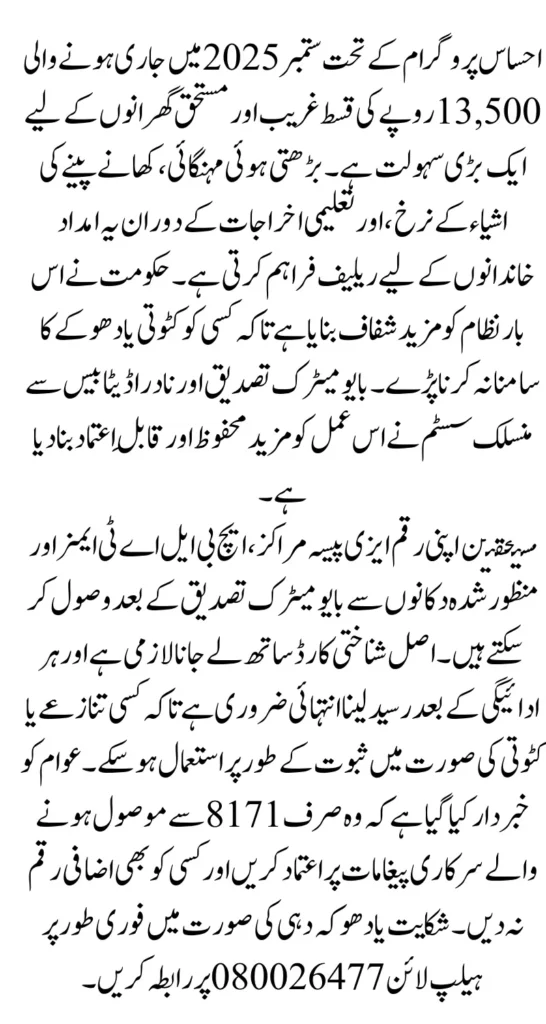Ehsaas Program Phase 3 Payments
Ehsaas Program Phase 3 Payments for September 2025 have been officially launched by the Government of Pakistan. Each eligible family is entitled to receive Rs. 13,500, an amount that has become a lifeline for poor households across the country. With food prices, fuel rates, and education expenses continuously rising, this installment is more than just financial aid—it is a direct effort to protect Pakistan’s most vulnerable families from falling deeper into poverty.

Unlike earlier phases, Phase 3 is designed to ensure transparency and easy access. Beneficiaries no longer have to rely on agents or face unauthorized deductions, as the entire system has been shifted towards biometric verification and digital record checks. Families can verify their eligibility using the 8171 SMS service or through the official web portal, making the process faster, fairer, and more accessible for everyone.
You Can Also Read: BISP Double Payment September 2025
Quick Highlights of Phase 3 Payments
Before exploring details, here are the most important things families should know about the current installment.
- Installment amount: Rs. 13,500 per eligible family
- Start of rollout: First week of September 2025
- Eligibility check: CNIC to 8171 or via the official web portal
- Collection points: Ehsaas cash centers, HBL ATMs, and authorized shops
- Helpline number: 0800-26477 for complaints and queries
These highlights give beneficiaries a quick overview of the process and help them prepare in advance, saving both time and effort.
You Can Also Read: BISP Payment Status Exiting UCT for Recertification
What Makes Phase 3 Different?
Phase 3 of the Ehsaas Program comes with important changes that make it more effective compared to previous installments. The government has integrated NADRA’s updated database with the Ehsaas system to ensure that only deserving families receive payments. This step reduces errors and prevents fraudulent claims.
Another major change is the use of biometric verification. Payments can only be collected once the beneficiary verifies their thumbprint or fingerprint on the system. This ensures that no one else can withdraw the money on their behalf. Additionally, more distribution centers and digital banking channels have been introduced so that people living in rural areas do not need to travel long distances.
- Biometric verification ensures transparency
- Payments available through multiple official channels
- NADRA-linked verification reduces errors
You Can Also Read: PM E-Fan Replacement Program Convert to Solar
Who Qualifies for Ehsaas Phase 3?
Eligibility is one of the most important aspects of this installment. The government has set clear conditions to make sure funds go only to households that need them the most. Families already registered in earlier Ehsaas or BISP phases will continue to receive their payments unless their status has changed.
To qualify, households must fall below the poverty threshold. Families owning large assets such as houses, cars, or businesses are excluded. The program gives priority to widows, single mothers, people with disabilities, and households with children in schools, as these groups are often the most vulnerable.
Eligibility checklist:
- Household income below the poverty line
- No government employees in the family
- No ownership of major property or business assets
- Valid CNIC registered with BISP/Ehsaas
You Can Also Read: PMT 2025 Complete Guide Score, NADRA Profiling
How to Check Eligibility via 8171
Beneficiaries can easily confirm their eligibility and payment status through two official methods:
1. SMS Method
Send your 13-digit CNIC number to 8171. Within minutes, you will receive a reply with details about your eligibility and installment status. Keep this SMS safe, as it serves as proof when collecting your payment.
2. Web Portal Method
Visit the official 8171 Ehsaas portal, enter your CNIC number, type the captcha code shown, and click submit. The portal will display your status, including whether your payment is ready and the location of your assigned collection point.
8171 Status Results and Their Meaning
| Status Shown | Meaning | Action Required |
|---|---|---|
| Payment Ready | Funds are available for withdrawal | Visit collection center with CNIC |
| Under Verification | CNIC and household details not cleared | Visit BISP/NADRA office to update records |
| Not Eligible | Household does not meet criteria | No action; cannot claim installment |
| Payment Pending | Payment delayed due to technical check | Wait for SMS or check portal after 1 week |
This simple guide helps families understand their eligibility without confusion.
BISP Payment Schedule and Rollout Plan
The release of payments has been divided into different stages to prevent overcrowding at collection centers. Families living in major cities receive their funds first because they account for the largest number of registrations. After that, the program moves to smaller towns and rural villages. Finally, cases that require extra verification, such as families with incomplete records or fingerprint mismatches, are processed at the end.
This phased rollout ensures that the distribution process remains smooth, avoids long queues, and makes the collection experience less stressful for women and elderly beneficiaries. Families are strongly advised to confirm their status via 8171 before leaving for collection points.
- Stage 1: Urban centers and big cities
- Stage 2: Towns and rural villages
- Stage 3: Pending or special verification cases
You Can Also Read: BISP Payment Alert July–September Installments
Where and How to Collect Payments
Beneficiaries have multiple options for collecting their payments. Each option has been designed to ensure convenience, especially for families living in rural or remote areas. Payments can be collected from Ehsaas Cash Centers, HBL ATMs, or authorized retail shops.
At all collection points, biometric verification is compulsory. Once the CNIC and thumbprint are confirmed, beneficiaries receive their payment in cash or through their preferred channel. Always make sure to take a printed receipt after the withdrawal, as it serves as proof in case of disputes or deductions.
Collection checklist:
- Carry your original CNIC (mandatory)
- Show the SMS or portal confirmation at the counter
- Always request and keep the receipt
Required Documents for Collection
To avoid delays and rejections at the counter, beneficiaries should carry all necessary documents. The most important one is the original CNIC. Payments cannot be processed with photocopies. In some cases, especially when family verification is required, a B-form may also be needed.
Expired CNICs should be renewed at NADRA before attempting to collect the installment. Those facing biometric issues such as worn-out fingerprints should carry the NADRA update slip as proof of re-verification.
Required documents:
- Original CNIC
- Confirmation SMS or portal screenshot
- B-form (if requested for family verification)
- NADRA update slip (for biometric mismatches)
You Can Also Read: BISP 8171 Introduces New Card for Inactive Eligible
Common Problems and Their Solutions
Even with improvements, some families may still face issues while receiving their payments. These include technical delays, biometric mismatches, or unlawful deductions by agents. Knowing the solutions in advance can help beneficiaries save time and stress.
- Biometric mismatch: Visit NADRA to re-verify fingerprints
- SMS not received: Retry later or use the 8171 portal
- Payment reversal: Contact the BISP office with proof of SMS or receipt
- Agent deductions: Report immediately to helpline 0800-26477
By taking quick action, families can ensure they receive their full installment without exploitation.
Fraud Prevention and Safety Tips
Fraud is a serious issue, especially in rural areas where misinformation spreads quickly. The government has urged all beneficiaries to remain alert and to use only official channels. Fake SMS messages, calls demanding service charges, and unauthorized collection agents are common tricks used by fraudsters.
Beneficiaries should remember that the only official SMS code is 8171. Payments are free of cost, and no extra fee should ever be paid to an agent. Always collect payments from authorized centers and keep receipts safe. If anything suspicious occurs, immediately call the helpline.
- Only trust 8171 for verification
- Do not pay extra charges to anyone
- Keep receipts and SMS proof safe
- Report fraud attempts via 0800-26477
Impact of Rs. 13,500 Installment
For millions of poor households, Rs. 13,500 makes a significant difference. Families often use this amount to purchase groceries such as flour, rice, pulses, and cooking oil. It also helps in paying school fees, buying books and uniforms for children, or covering urgent medical bills.
The government has ensured that payments are issued in the name of women, empowering them to make financial decisions. This strengthens the family unit, ensures that money is spent responsibly, and promotes better nutrition and education outcomes for children.
Conclusion
The Ehsaas Program Phase 3 is not just financial relief—it is a structured system that helps millions of families survive during tough economic conditions. By offering Rs. 13,500 per household, the government has made it possible for poor families to meet their essential needs such as food, education, and healthcare.
Beneficiaries should make sure to check their eligibility via 8171, carry their original CNIC, and collect payments only from official centers. Reporting fraud and keeping receipts are equally important for protection. With each new phase, the Ehsaas Program is becoming more transparent, digital, and supportive, ensuring that Pakistan’s poorest citizens are never left behind.


